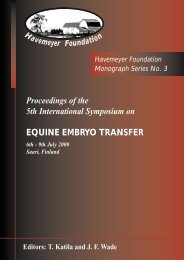Proceedings of a Workshop on - The Havemeyer Foundation
Proceedings of a Workshop on - The Havemeyer Foundation
Proceedings of a Workshop on - The Havemeyer Foundation
You also want an ePaper? Increase the reach of your titles
YUMPU automatically turns print PDFs into web optimized ePapers that Google loves.
<strong>Havemeyer</strong> Foundati<strong>on</strong> M<strong>on</strong>ograph Series No. 11<br />
DEVELOPMENT AND INNERVATION OF THE LARYNX<br />
C. Hahn<br />
Neuromuscular Diagnostic Laboratory, Royal (Dick) School <str<strong>on</strong>g>of</str<strong>on</strong>g> Veterinary Studies, <strong>The</strong> University <str<strong>on</strong>g>of</str<strong>on</strong>g><br />
Edinburgh, Easter Bush, Roslin, Midlothian EH25 9RG, UK<br />
A brief look at the evoluti<strong>on</strong> and development <str<strong>on</strong>g>of</str<strong>on</strong>g><br />
the larynx goes some way to explain the curious<br />
anatomy <str<strong>on</strong>g>of</str<strong>on</strong>g> this organ. About 400 milli<strong>on</strong> years<br />
ago, the lungfish evolved the ability to breathe air<br />
directly from the external envir<strong>on</strong>ment, perhaps<br />
because its watery home was periodically subject<br />
to drought (Ewings 1949). It developed a simple<br />
larynx-like slit behind the gills that allowed air<br />
into the swim-bladder when the creature was<br />
exposed to the atmosphere and that kept water out<br />
when it was submerged (Fig 1). As the<br />
descendants <str<strong>on</strong>g>of</str<strong>on</strong>g> the lungfish moved <strong>on</strong>to land, the<br />
swim-bladder evolved into a multi-compartment<br />
organ with a large surface area the sole functi<strong>on</strong> <str<strong>on</strong>g>of</str<strong>on</strong>g><br />
which was gas exchange. <strong>The</strong> larynx in the<br />
meantime developed adductor and abductor<br />
muscles and lateral cartilages (such as found in the<br />
axolotl), then separate arytenoid and cricoid<br />
cartilages (newt), primitive thyroid cartilages<br />
(alligators and their feathered relatives, the birds)<br />
and finally the complex mammalian larynx. As the<br />
survival <str<strong>on</strong>g>of</str<strong>on</strong>g> equids <strong>on</strong>ce depended <strong>on</strong> running l<strong>on</strong>g<br />
distances to escape predators, horses evolved a<br />
larynx that when fully abducted has an aperture<br />
Fig 1: Lungfish with modified swim bladder and dilator<br />
and sphincter muscles (modified from Ewings, V. (1949).<br />
<strong>The</strong> Comparative Anatomy and Physiology <str<strong>on</strong>g>of</str<strong>on</strong>g> the<br />
Larynx. William Heinemann, Medical Books, L<strong>on</strong>d<strong>on</strong>).<br />
that is larger than the trachea itself (this in sharp<br />
c<strong>on</strong>trast to the human larynx, where the abducted<br />
larynx allows for speech but is <strong>on</strong>ly half the<br />
diameter <str<strong>on</strong>g>of</str<strong>on</strong>g> the trachea).<br />
An appreciati<strong>on</strong> <str<strong>on</strong>g>of</str<strong>on</strong>g> the neuroanatomy <str<strong>on</strong>g>of</str<strong>on</strong>g><br />
laryngeal innervati<strong>on</strong> is a pre-requisite to<br />
understanding the pathology <str<strong>on</strong>g>of</str<strong>on</strong>g> recurrent laryngeal<br />
neuropathy. <strong>The</strong> main source <str<strong>on</strong>g>of</str<strong>on</strong>g> laryngeal<br />
innervati<strong>on</strong> <str<strong>on</strong>g>of</str<strong>on</strong>g> the equine larynx is the ipsilateral<br />
recurrent laryngeal nerve (rln). Motor neur<strong>on</strong>s <str<strong>on</strong>g>of</str<strong>on</strong>g><br />
the rln are based in the nucleus ambiguus in the<br />
caudal brainstem. This nucleus was recently<br />
localised in the horse (Hackett 2000) and was<br />
found to be a loosely organised column <str<strong>on</strong>g>of</str<strong>on</strong>g> cells in<br />
the ventrolateral medulla obl<strong>on</strong>gata (Fig 2). A<br />
somatotopic distributi<strong>on</strong> <str<strong>on</strong>g>of</str<strong>on</strong>g> adductor and abductor<br />
motor neur<strong>on</strong>s was not apparent but neur<strong>on</strong>s<br />
innervating the cricoarytenoideus lateralis muscle<br />
were observed throughout the nucleus, whereas<br />
neur<strong>on</strong>s innervating the cricoarytenoideus<br />
dorsalis tended to be situated more rostrally.<br />
Nucleus ambiguous ax<strong>on</strong>s loop around the<br />
parasympathetic nucleus <str<strong>on</strong>g>of</str<strong>on</strong>g> the vagus to emerge<br />
from the brainstem as ax<strong>on</strong>s <str<strong>on</strong>g>of</str<strong>on</strong>g> the internal branch<br />
<str<strong>on</strong>g>of</str<strong>on</strong>g> cranial nerve (CN) XI. <strong>The</strong>y <strong>on</strong>ly join the vagus<br />
nerve (CN X) <strong>on</strong> leaving the skull through the<br />
jugular foramen and tympano-occipital fissure.<br />
Cranial movement <str<strong>on</strong>g>of</str<strong>on</strong>g> the head during<br />
embryogenesis, and differential degenerati<strong>on</strong> <str<strong>on</strong>g>of</str<strong>on</strong>g><br />
the 6th aortic arch, resulted in extremely l<strong>on</strong>g<br />
nerves with the left and right nerves having<br />
different pathways. <strong>The</strong> left nerve loops around<br />
the aorta while the right takes a shorter route<br />
around the right subclavian artery. Including its<br />
vagal course, the total length from neur<strong>on</strong>al cell<br />
body to larynx <str<strong>on</strong>g>of</str<strong>on</strong>g> the left rln can be up to 250 cm<br />
in length, making it twice as l<strong>on</strong>g as other motor<br />
nerves in the horse and 31 cm l<strong>on</strong>ger than the right<br />
rln (Cole 1946).<br />
3








